University Essay: Cross-Cultural Competence and Barriers in Singapore
VerifiedAdded on 2020/04/07
|7
|1646
|206
Essay
AI Summary
This essay examines the concept of cross-cultural competence and the barriers to effective cross-cultural interactions within the context of Singaporean society. It begins by defining cross-cultural competence, drawing upon the work of Johnson, Lenartowicz, and Apud, who emphasize the importance of knowledge, skill, and attitude. The essay then delves into the factors influencing intercultural communication and the role of personal identity and cultural awareness. It also discusses the concept of cross-cultural training and the dimensions of cultural knowledge, including culture-general and culture-specific knowledge, and the acquisition of knowledge. The essay further explores the skill dimension of cross-cultural competency. The second part of the essay focuses on the barriers to cross-cultural interactions, as defined by Rozkwitalska, including cultural contingencies, national culture-related factors, organizational factors, and individual factors such as perception barriers and ethnocentrism. The essay then presents two case studies: one illustrating cultural competence in social work practice and the other highlighting cross-cultural communication barriers in the workplace. These case studies demonstrate the practical implications of the concepts discussed, emphasizing the importance of cultural sensitivity and the challenges of navigating cultural differences in a multicultural environment. The essay concludes by underscoring the relevance of these case studies in understanding both the achievements of and obstacles to successful cross-cultural interactions.
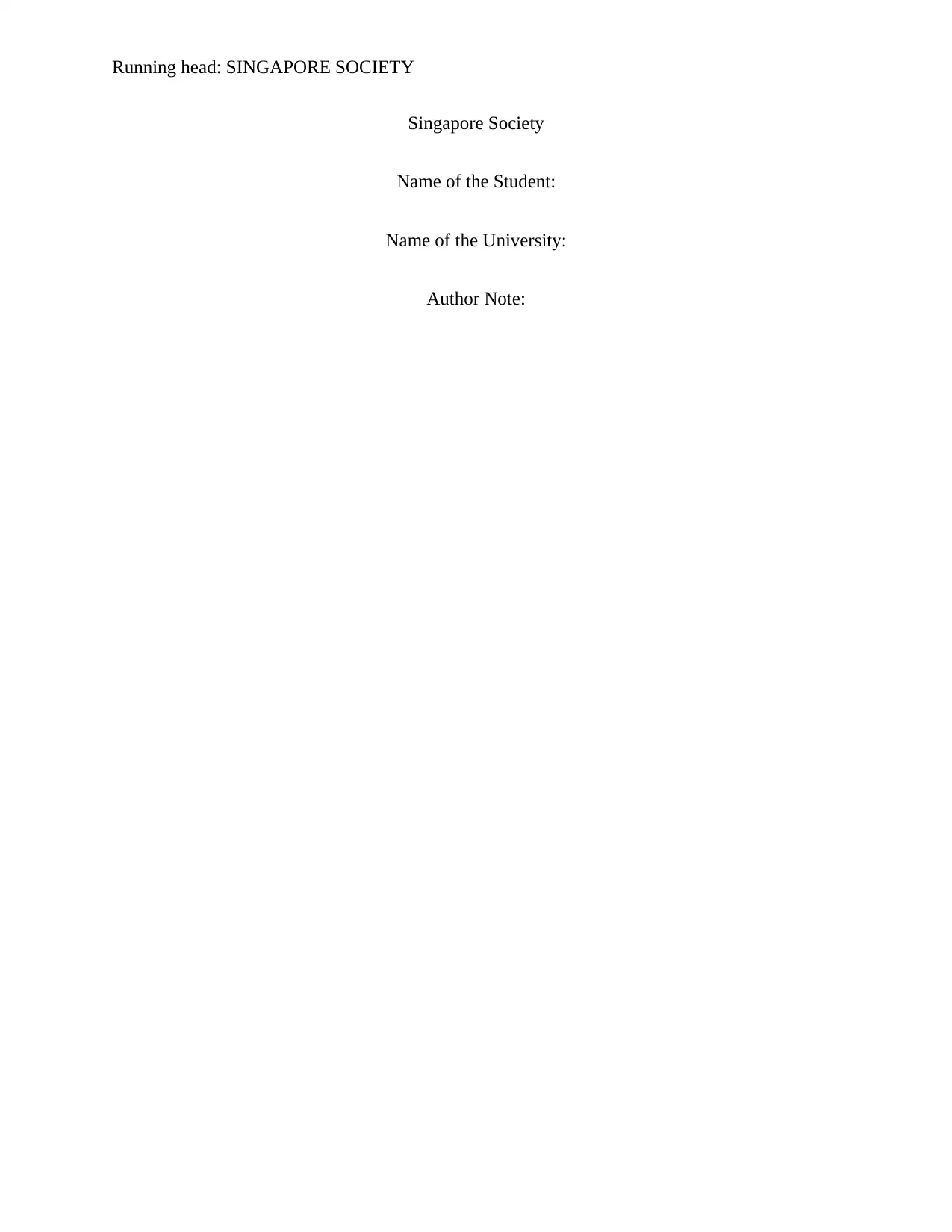
Running head: SINGAPORE SOCIETY
Singapore Society
Name of the Student:
Name of the University:
Author Note:
Singapore Society
Name of the Student:
Name of the University:
Author Note:
Paraphrase This Document
Need a fresh take? Get an instant paraphrase of this document with our AI Paraphraser
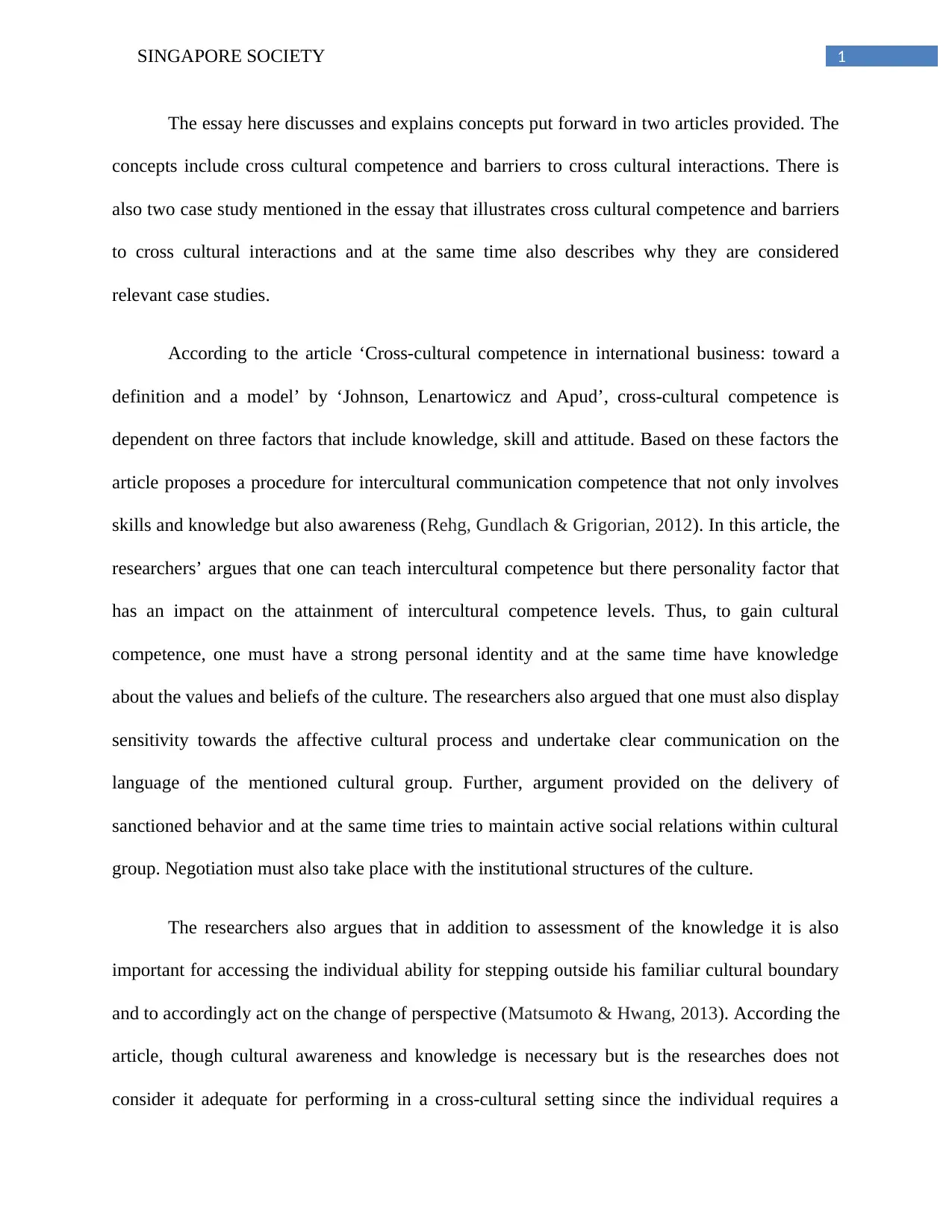
1SINGAPORE SOCIETY
The essay here discusses and explains concepts put forward in two articles provided. The
concepts include cross cultural competence and barriers to cross cultural interactions. There is
also two case study mentioned in the essay that illustrates cross cultural competence and barriers
to cross cultural interactions and at the same time also describes why they are considered
relevant case studies.
According to the article ‘Cross-cultural competence in international business: toward a
definition and a model’ by ‘Johnson, Lenartowicz and Apud’, cross-cultural competence is
dependent on three factors that include knowledge, skill and attitude. Based on these factors the
article proposes a procedure for intercultural communication competence that not only involves
skills and knowledge but also awareness (Rehg, Gundlach & Grigorian, 2012). In this article, the
researchers’ argues that one can teach intercultural competence but there personality factor that
has an impact on the attainment of intercultural competence levels. Thus, to gain cultural
competence, one must have a strong personal identity and at the same time have knowledge
about the values and beliefs of the culture. The researchers also argued that one must also display
sensitivity towards the affective cultural process and undertake clear communication on the
language of the mentioned cultural group. Further, argument provided on the delivery of
sanctioned behavior and at the same time tries to maintain active social relations within cultural
group. Negotiation must also take place with the institutional structures of the culture.
The researchers also argues that in addition to assessment of the knowledge it is also
important for accessing the individual ability for stepping outside his familiar cultural boundary
and to accordingly act on the change of perspective (Matsumoto & Hwang, 2013). According the
article, though cultural awareness and knowledge is necessary but is the researches does not
consider it adequate for performing in a cross-cultural setting since the individual requires a
The essay here discusses and explains concepts put forward in two articles provided. The
concepts include cross cultural competence and barriers to cross cultural interactions. There is
also two case study mentioned in the essay that illustrates cross cultural competence and barriers
to cross cultural interactions and at the same time also describes why they are considered
relevant case studies.
According to the article ‘Cross-cultural competence in international business: toward a
definition and a model’ by ‘Johnson, Lenartowicz and Apud’, cross-cultural competence is
dependent on three factors that include knowledge, skill and attitude. Based on these factors the
article proposes a procedure for intercultural communication competence that not only involves
skills and knowledge but also awareness (Rehg, Gundlach & Grigorian, 2012). In this article, the
researchers’ argues that one can teach intercultural competence but there personality factor that
has an impact on the attainment of intercultural competence levels. Thus, to gain cultural
competence, one must have a strong personal identity and at the same time have knowledge
about the values and beliefs of the culture. The researchers also argued that one must also display
sensitivity towards the affective cultural process and undertake clear communication on the
language of the mentioned cultural group. Further, argument provided on the delivery of
sanctioned behavior and at the same time tries to maintain active social relations within cultural
group. Negotiation must also take place with the institutional structures of the culture.
The researchers also argues that in addition to assessment of the knowledge it is also
important for accessing the individual ability for stepping outside his familiar cultural boundary
and to accordingly act on the change of perspective (Matsumoto & Hwang, 2013). According the
article, though cultural awareness and knowledge is necessary but is the researches does not
consider it adequate for performing in a cross-cultural setting since the individual requires a
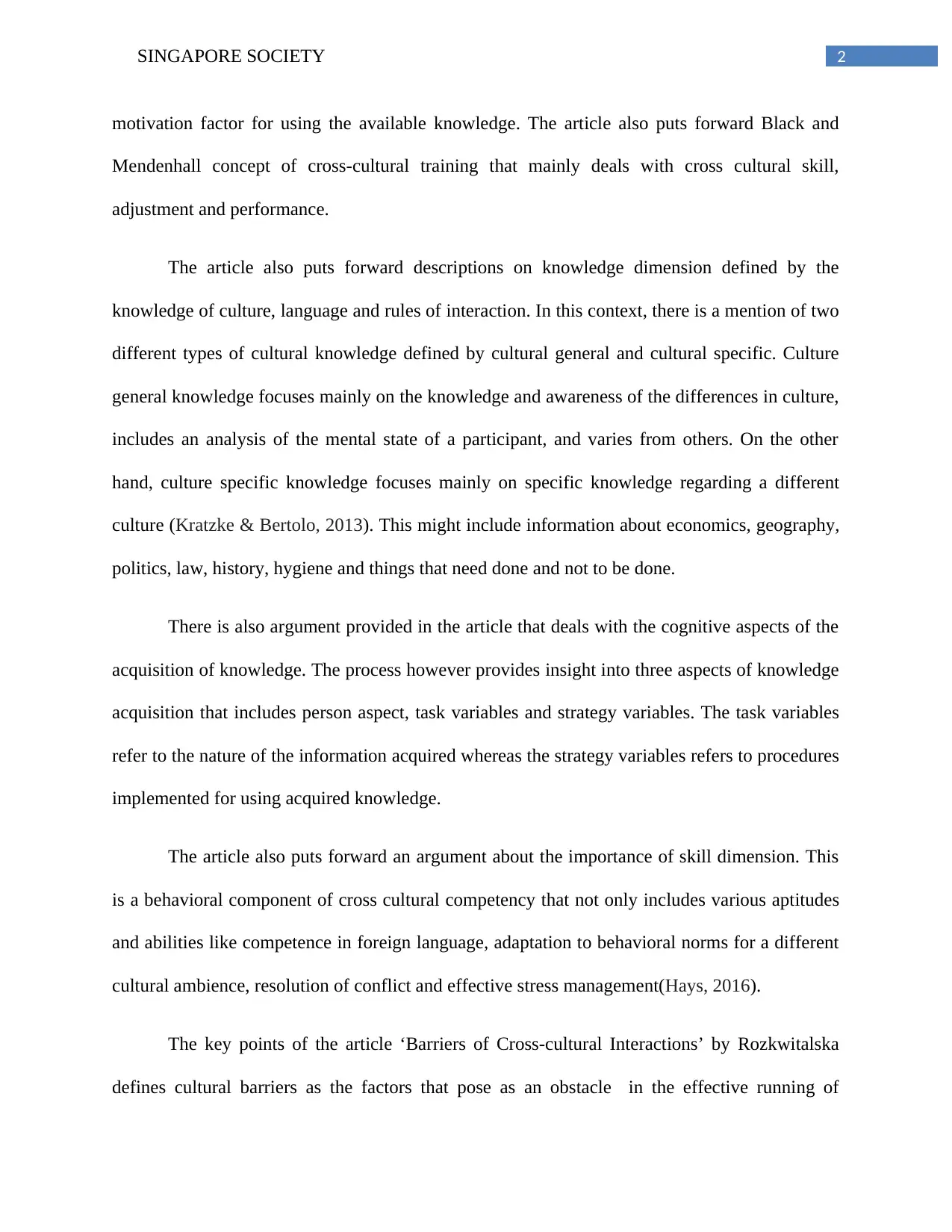
2SINGAPORE SOCIETY
motivation factor for using the available knowledge. The article also puts forward Black and
Mendenhall concept of cross-cultural training that mainly deals with cross cultural skill,
adjustment and performance.
The article also puts forward descriptions on knowledge dimension defined by the
knowledge of culture, language and rules of interaction. In this context, there is a mention of two
different types of cultural knowledge defined by cultural general and cultural specific. Culture
general knowledge focuses mainly on the knowledge and awareness of the differences in culture,
includes an analysis of the mental state of a participant, and varies from others. On the other
hand, culture specific knowledge focuses mainly on specific knowledge regarding a different
culture (Kratzke & Bertolo, 2013). This might include information about economics, geography,
politics, law, history, hygiene and things that need done and not to be done.
There is also argument provided in the article that deals with the cognitive aspects of the
acquisition of knowledge. The process however provides insight into three aspects of knowledge
acquisition that includes person aspect, task variables and strategy variables. The task variables
refer to the nature of the information acquired whereas the strategy variables refers to procedures
implemented for using acquired knowledge.
The article also puts forward an argument about the importance of skill dimension. This
is a behavioral component of cross cultural competency that not only includes various aptitudes
and abilities like competence in foreign language, adaptation to behavioral norms for a different
cultural ambience, resolution of conflict and effective stress management(Hays, 2016).
The key points of the article ‘Barriers of Cross-cultural Interactions’ by Rozkwitalska
defines cultural barriers as the factors that pose as an obstacle in the effective running of
motivation factor for using the available knowledge. The article also puts forward Black and
Mendenhall concept of cross-cultural training that mainly deals with cross cultural skill,
adjustment and performance.
The article also puts forward descriptions on knowledge dimension defined by the
knowledge of culture, language and rules of interaction. In this context, there is a mention of two
different types of cultural knowledge defined by cultural general and cultural specific. Culture
general knowledge focuses mainly on the knowledge and awareness of the differences in culture,
includes an analysis of the mental state of a participant, and varies from others. On the other
hand, culture specific knowledge focuses mainly on specific knowledge regarding a different
culture (Kratzke & Bertolo, 2013). This might include information about economics, geography,
politics, law, history, hygiene and things that need done and not to be done.
There is also argument provided in the article that deals with the cognitive aspects of the
acquisition of knowledge. The process however provides insight into three aspects of knowledge
acquisition that includes person aspect, task variables and strategy variables. The task variables
refer to the nature of the information acquired whereas the strategy variables refers to procedures
implemented for using acquired knowledge.
The article also puts forward an argument about the importance of skill dimension. This
is a behavioral component of cross cultural competency that not only includes various aptitudes
and abilities like competence in foreign language, adaptation to behavioral norms for a different
cultural ambience, resolution of conflict and effective stress management(Hays, 2016).
The key points of the article ‘Barriers of Cross-cultural Interactions’ by Rozkwitalska
defines cultural barriers as the factors that pose as an obstacle in the effective running of
⊘ This is a preview!⊘
Do you want full access?
Subscribe today to unlock all pages.

Trusted by 1+ million students worldwide
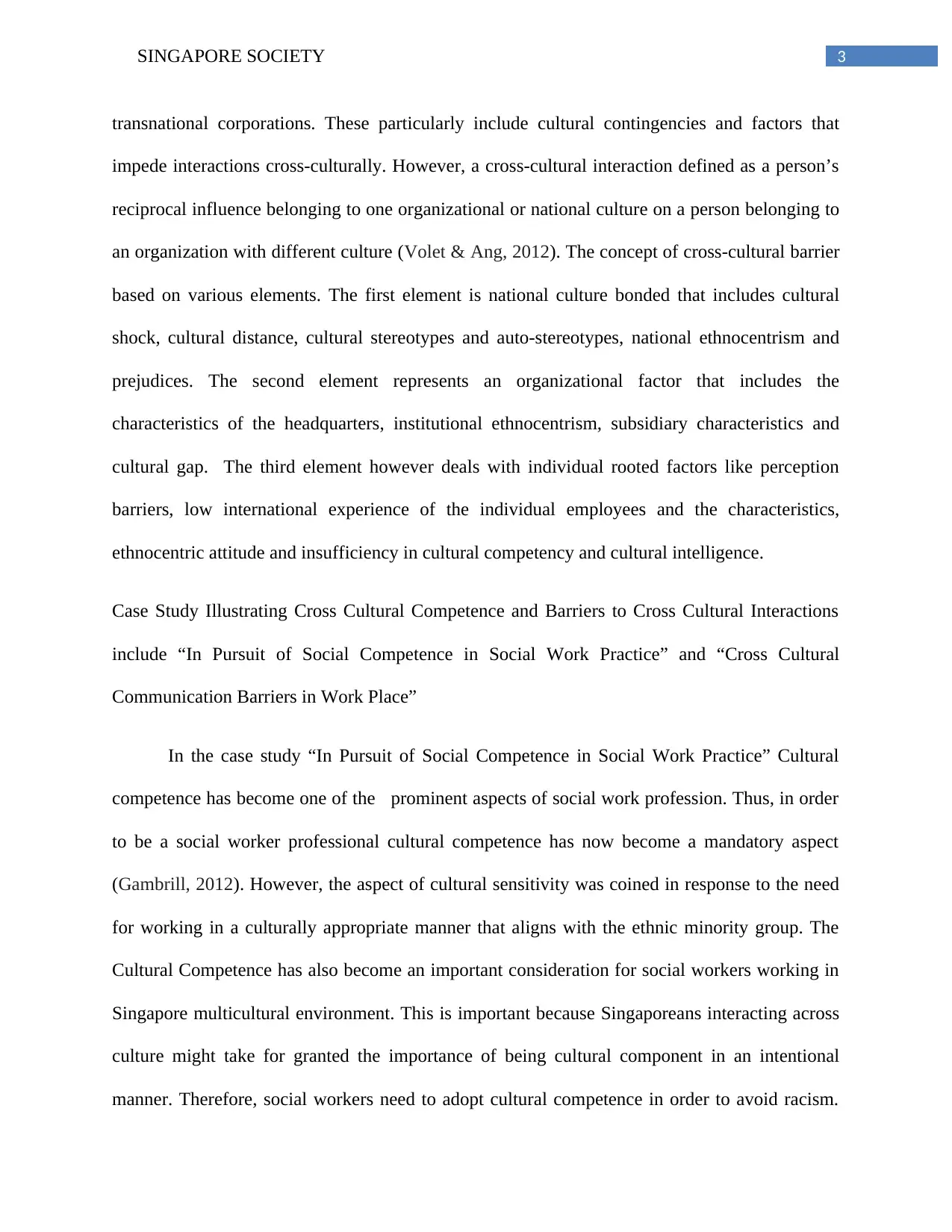
3SINGAPORE SOCIETY
transnational corporations. These particularly include cultural contingencies and factors that
impede interactions cross-culturally. However, a cross-cultural interaction defined as a person’s
reciprocal influence belonging to one organizational or national culture on a person belonging to
an organization with different culture (Volet & Ang, 2012). The concept of cross-cultural barrier
based on various elements. The first element is national culture bonded that includes cultural
shock, cultural distance, cultural stereotypes and auto-stereotypes, national ethnocentrism and
prejudices. The second element represents an organizational factor that includes the
characteristics of the headquarters, institutional ethnocentrism, subsidiary characteristics and
cultural gap. The third element however deals with individual rooted factors like perception
barriers, low international experience of the individual employees and the characteristics,
ethnocentric attitude and insufficiency in cultural competency and cultural intelligence.
Case Study Illustrating Cross Cultural Competence and Barriers to Cross Cultural Interactions
include “In Pursuit of Social Competence in Social Work Practice” and “Cross Cultural
Communication Barriers in Work Place”
In the case study “In Pursuit of Social Competence in Social Work Practice” Cultural
competence has become one of the prominent aspects of social work profession. Thus, in order
to be a social worker professional cultural competence has now become a mandatory aspect
(Gambrill, 2012). However, the aspect of cultural sensitivity was coined in response to the need
for working in a culturally appropriate manner that aligns with the ethnic minority group. The
Cultural Competence has also become an important consideration for social workers working in
Singapore multicultural environment. This is important because Singaporeans interacting across
culture might take for granted the importance of being cultural component in an intentional
manner. Therefore, social workers need to adopt cultural competence in order to avoid racism.
transnational corporations. These particularly include cultural contingencies and factors that
impede interactions cross-culturally. However, a cross-cultural interaction defined as a person’s
reciprocal influence belonging to one organizational or national culture on a person belonging to
an organization with different culture (Volet & Ang, 2012). The concept of cross-cultural barrier
based on various elements. The first element is national culture bonded that includes cultural
shock, cultural distance, cultural stereotypes and auto-stereotypes, national ethnocentrism and
prejudices. The second element represents an organizational factor that includes the
characteristics of the headquarters, institutional ethnocentrism, subsidiary characteristics and
cultural gap. The third element however deals with individual rooted factors like perception
barriers, low international experience of the individual employees and the characteristics,
ethnocentric attitude and insufficiency in cultural competency and cultural intelligence.
Case Study Illustrating Cross Cultural Competence and Barriers to Cross Cultural Interactions
include “In Pursuit of Social Competence in Social Work Practice” and “Cross Cultural
Communication Barriers in Work Place”
In the case study “In Pursuit of Social Competence in Social Work Practice” Cultural
competence has become one of the prominent aspects of social work profession. Thus, in order
to be a social worker professional cultural competence has now become a mandatory aspect
(Gambrill, 2012). However, the aspect of cultural sensitivity was coined in response to the need
for working in a culturally appropriate manner that aligns with the ethnic minority group. The
Cultural Competence has also become an important consideration for social workers working in
Singapore multicultural environment. This is important because Singaporeans interacting across
culture might take for granted the importance of being cultural component in an intentional
manner. Therefore, social workers need to adopt cultural competence in order to avoid racism.
Paraphrase This Document
Need a fresh take? Get an instant paraphrase of this document with our AI Paraphraser
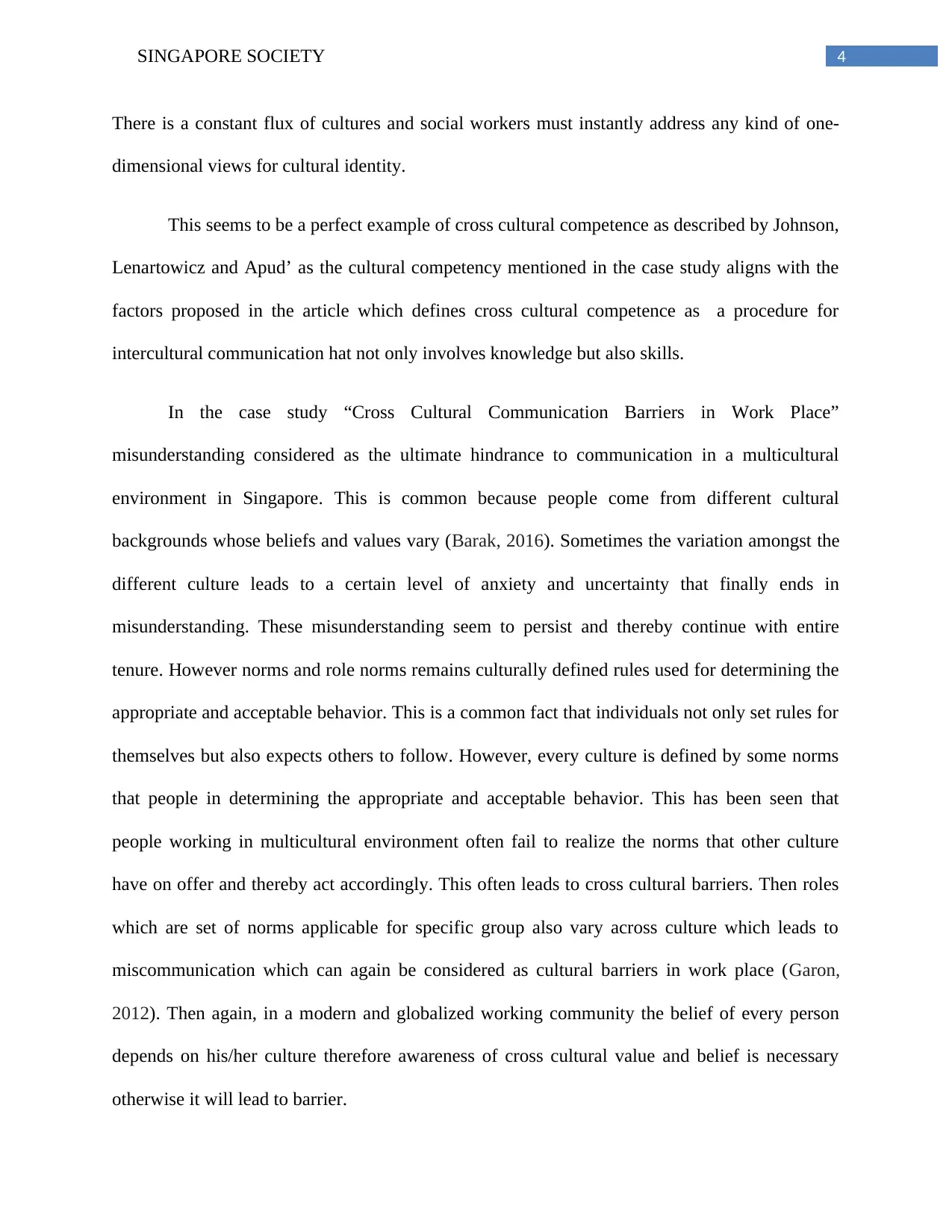
4SINGAPORE SOCIETY
There is a constant flux of cultures and social workers must instantly address any kind of one-
dimensional views for cultural identity.
This seems to be a perfect example of cross cultural competence as described by Johnson,
Lenartowicz and Apud’ as the cultural competency mentioned in the case study aligns with the
factors proposed in the article which defines cross cultural competence as a procedure for
intercultural communication hat not only involves knowledge but also skills.
In the case study “Cross Cultural Communication Barriers in Work Place”
misunderstanding considered as the ultimate hindrance to communication in a multicultural
environment in Singapore. This is common because people come from different cultural
backgrounds whose beliefs and values vary (Barak, 2016). Sometimes the variation amongst the
different culture leads to a certain level of anxiety and uncertainty that finally ends in
misunderstanding. These misunderstanding seem to persist and thereby continue with entire
tenure. However norms and role norms remains culturally defined rules used for determining the
appropriate and acceptable behavior. This is a common fact that individuals not only set rules for
themselves but also expects others to follow. However, every culture is defined by some norms
that people in determining the appropriate and acceptable behavior. This has been seen that
people working in multicultural environment often fail to realize the norms that other culture
have on offer and thereby act accordingly. This often leads to cross cultural barriers. Then roles
which are set of norms applicable for specific group also vary across culture which leads to
miscommunication which can again be considered as cultural barriers in work place (Garon,
2012). Then again, in a modern and globalized working community the belief of every person
depends on his/her culture therefore awareness of cross cultural value and belief is necessary
otherwise it will lead to barrier.
There is a constant flux of cultures and social workers must instantly address any kind of one-
dimensional views for cultural identity.
This seems to be a perfect example of cross cultural competence as described by Johnson,
Lenartowicz and Apud’ as the cultural competency mentioned in the case study aligns with the
factors proposed in the article which defines cross cultural competence as a procedure for
intercultural communication hat not only involves knowledge but also skills.
In the case study “Cross Cultural Communication Barriers in Work Place”
misunderstanding considered as the ultimate hindrance to communication in a multicultural
environment in Singapore. This is common because people come from different cultural
backgrounds whose beliefs and values vary (Barak, 2016). Sometimes the variation amongst the
different culture leads to a certain level of anxiety and uncertainty that finally ends in
misunderstanding. These misunderstanding seem to persist and thereby continue with entire
tenure. However norms and role norms remains culturally defined rules used for determining the
appropriate and acceptable behavior. This is a common fact that individuals not only set rules for
themselves but also expects others to follow. However, every culture is defined by some norms
that people in determining the appropriate and acceptable behavior. This has been seen that
people working in multicultural environment often fail to realize the norms that other culture
have on offer and thereby act accordingly. This often leads to cross cultural barriers. Then roles
which are set of norms applicable for specific group also vary across culture which leads to
miscommunication which can again be considered as cultural barriers in work place (Garon,
2012). Then again, in a modern and globalized working community the belief of every person
depends on his/her culture therefore awareness of cross cultural value and belief is necessary
otherwise it will lead to barrier.
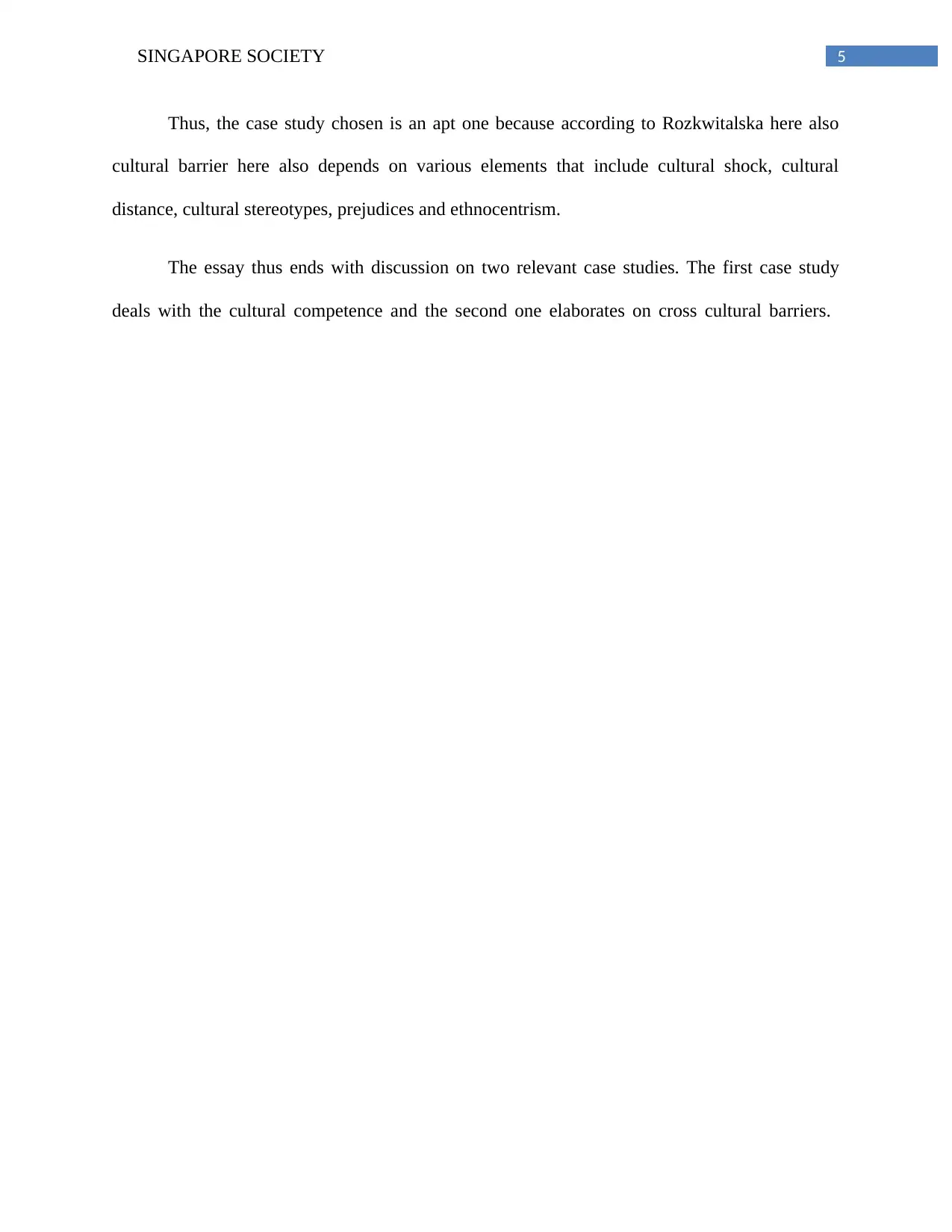
5SINGAPORE SOCIETY
Thus, the case study chosen is an apt one because according to Rozkwitalska here also
cultural barrier here also depends on various elements that include cultural shock, cultural
distance, cultural stereotypes, prejudices and ethnocentrism.
The essay thus ends with discussion on two relevant case studies. The first case study
deals with the cultural competence and the second one elaborates on cross cultural barriers.
Thus, the case study chosen is an apt one because according to Rozkwitalska here also
cultural barrier here also depends on various elements that include cultural shock, cultural
distance, cultural stereotypes, prejudices and ethnocentrism.
The essay thus ends with discussion on two relevant case studies. The first case study
deals with the cultural competence and the second one elaborates on cross cultural barriers.
⊘ This is a preview!⊘
Do you want full access?
Subscribe today to unlock all pages.

Trusted by 1+ million students worldwide
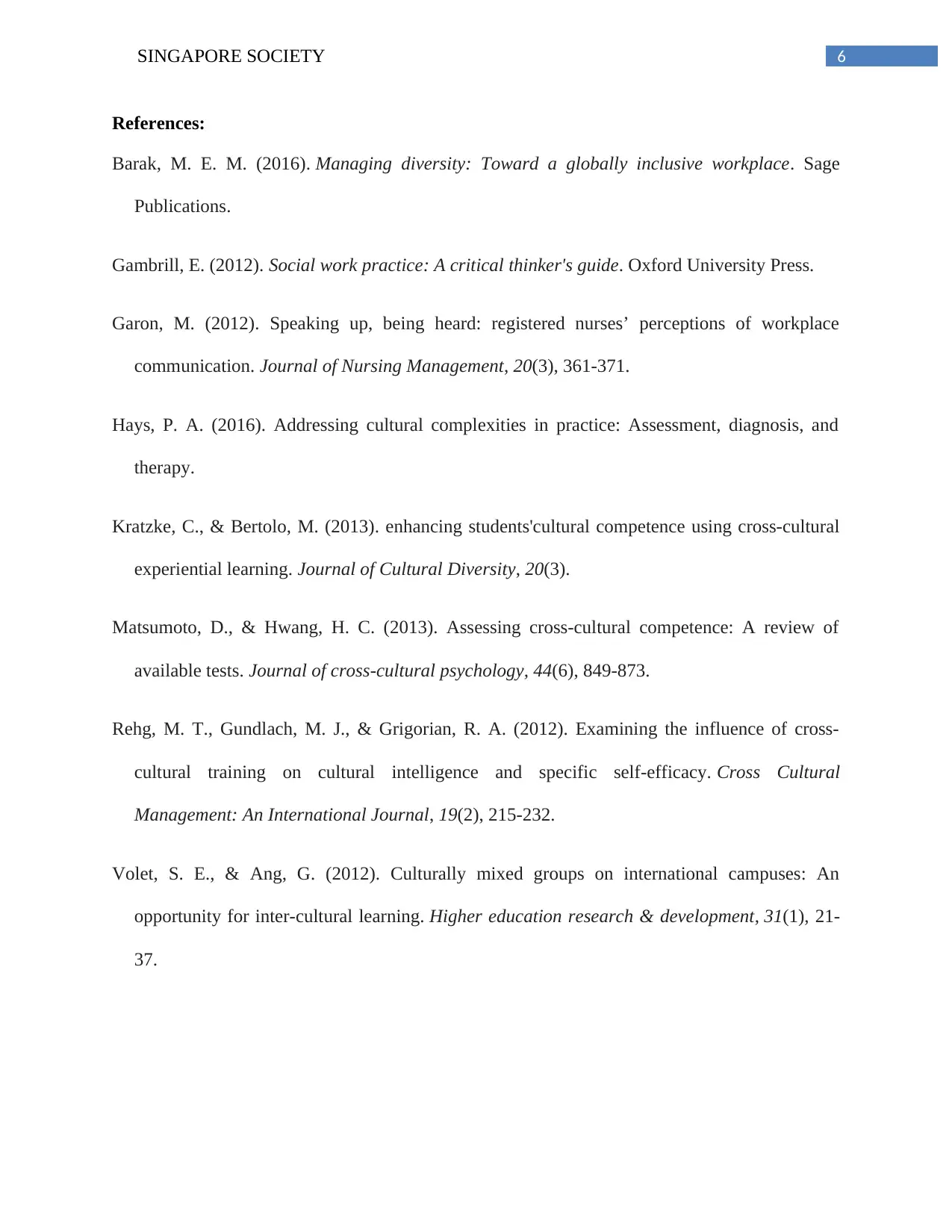
6SINGAPORE SOCIETY
References:
Barak, M. E. M. (2016). Managing diversity: Toward a globally inclusive workplace. Sage
Publications.
Gambrill, E. (2012). Social work practice: A critical thinker's guide. Oxford University Press.
Garon, M. (2012). Speaking up, being heard: registered nurses’ perceptions of workplace
communication. Journal of Nursing Management, 20(3), 361-371.
Hays, P. A. (2016). Addressing cultural complexities in practice: Assessment, diagnosis, and
therapy.
Kratzke, C., & Bertolo, M. (2013). enhancing students'cultural competence using cross-cultural
experiential learning. Journal of Cultural Diversity, 20(3).
Matsumoto, D., & Hwang, H. C. (2013). Assessing cross-cultural competence: A review of
available tests. Journal of cross-cultural psychology, 44(6), 849-873.
Rehg, M. T., Gundlach, M. J., & Grigorian, R. A. (2012). Examining the influence of cross-
cultural training on cultural intelligence and specific self-efficacy. Cross Cultural
Management: An International Journal, 19(2), 215-232.
Volet, S. E., & Ang, G. (2012). Culturally mixed groups on international campuses: An
opportunity for inter-cultural learning. Higher education research & development, 31(1), 21-
37.
References:
Barak, M. E. M. (2016). Managing diversity: Toward a globally inclusive workplace. Sage
Publications.
Gambrill, E. (2012). Social work practice: A critical thinker's guide. Oxford University Press.
Garon, M. (2012). Speaking up, being heard: registered nurses’ perceptions of workplace
communication. Journal of Nursing Management, 20(3), 361-371.
Hays, P. A. (2016). Addressing cultural complexities in practice: Assessment, diagnosis, and
therapy.
Kratzke, C., & Bertolo, M. (2013). enhancing students'cultural competence using cross-cultural
experiential learning. Journal of Cultural Diversity, 20(3).
Matsumoto, D., & Hwang, H. C. (2013). Assessing cross-cultural competence: A review of
available tests. Journal of cross-cultural psychology, 44(6), 849-873.
Rehg, M. T., Gundlach, M. J., & Grigorian, R. A. (2012). Examining the influence of cross-
cultural training on cultural intelligence and specific self-efficacy. Cross Cultural
Management: An International Journal, 19(2), 215-232.
Volet, S. E., & Ang, G. (2012). Culturally mixed groups on international campuses: An
opportunity for inter-cultural learning. Higher education research & development, 31(1), 21-
37.
1 out of 7
Related Documents
Your All-in-One AI-Powered Toolkit for Academic Success.
+13062052269
info@desklib.com
Available 24*7 on WhatsApp / Email
![[object Object]](/_next/static/media/star-bottom.7253800d.svg)
Unlock your academic potential
Copyright © 2020–2025 A2Z Services. All Rights Reserved. Developed and managed by ZUCOL.





